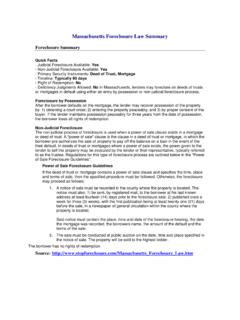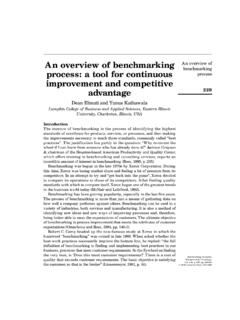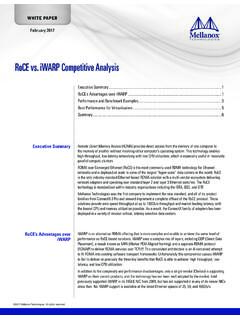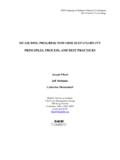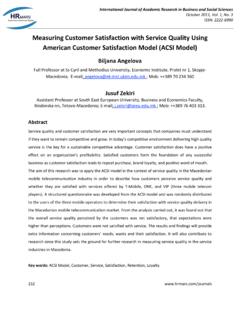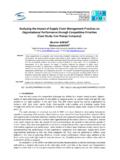Transcription of Risk: Defining it, Measuring it, and Managing it
1 Risk: Defining it, Measuring it, and Managing it Robert A. Jaeger Vice Chairman Chief Investment Officer November 2000. Contents Defining Risk 1 Managing Risk 6. Measuring Risk 2 Prudence 9. Evaluation Associates Capital Markets, Inc. November 2000. The investment business has spawned a thriving sub-business devoted to the measurement of risk. This sub-business features a variety of wonderfully sophisticated approaches to the measurement of price volatility. But the measurement of volatility does not improve our understanding of risk, since the essence of risk is not volatility, but uncertainty. Indeed, highly precise measures of volatility can get in the way of intelligent risk management by suggesting a level of accuracy and control that does not exist.
2 I. Defining Risk Whatever risk is, it is not the annualized standard deviation of the daily (or weekly, or monthly) returns. Nor is it value at risk, measured at the 95% (or 99%, or ) confidence level. Nor is it semi-variance, or shortfall probability, or any other simple quantitative measure. These various measures may shed light on risk, and may help us to estimate risk, but they do not define the nature of risk. People worry about risk in a wide variety of non-financial situations where the various measures just mentioned would not apply at all. When people worry about whom to marry, what college to attend, or whether to accept a certain job, they weigh reward against risk, benefit against cost, upside against downside, but they do so without the elaborate quantitative machinery available to every investment professional.
3 The quantitative machinery is not essential to risk assessment, and may even hinder intelligent risk assessment. The key element in risk analysis, both in the financial arena and other arenas, is a form of scenario analysis in which the risk-related questions boil down to these: What are the possible bad outcomes? How likely are they? How bad are they? In some situations it may be possible to attach numerical values to the probabilities and the degree of badness, in other situations that will be impossible. If Jane is trying to decide whether to marry John, it would be absurd to assign definite probabilities and definite disutility units to all the different ways in which a marriage can go wrong.
4 Even someone worried about the risks of airplane travel would have a hard time calculating the probability of dying as opposed to the probability of losing a limb. And he would have an equally hard time quantifying the difference in undesirability of those outcomes, despite the fact that the flight insurance policy might pay ten times more for death than for the loss of a limb. In many situations the most that we can do is to order the scenarios, without being able to measure them. We can say that this outcome is more likely than that one, or this outcome is more undesirable than that one, without being able to attach definite values to the probabilities or the level of undesirability.
5 Financial professionals tend to think that investment risk is more easily quantifiable than marriage risk, career risk, and air travel risk, but this is an illusion. Investors have access to an endless stream of numbers, and access to many ways of crunching those numbers, but that does not mean that the numbers measure risk as we ordinarily understand it. We all know the story about the man looking for his keys at night under the lamppost. The joke is that he is looking under the lamppost not because the keys are there, but because the light is better 1. Evaluation Associates Capital Markets, Inc. November 2000. there. The numbers can shed a tremendous amount of light, but the keys may be somewhere else.
6 If we had to offer a simple definition of risk it would be something like expected pain, . which would combine some rough measure of the likelihood of various unfavorable outcomes with some rough measure of how unfavorable those outcomes are. This simple definition at least captures the fact that risk judgments depend on two elements: the likelihood of various painful outcomes, and the level of pain associated with those outcomes. Think of the difference between AM radio and FM radio. AM radio works by modulating the amplitude of the signal, FM radio works by modulating the frequency of the signal. Risk combines frequency with amplitude. But this definition is, of course, an idealized over- simplification, since in most real-life situations we have no real hope of Measuring either the probabilities or the level of pain.
7 Investment situations give us the opportunity to measure standard deviations, values at risk, and all sorts of other numbers, but that is not the same as Measuring risk. II. Measuring Risk Since standard deviation is the most common proxy for risk (even VAR measures are driven ultimately by standard deviation), the easiest way to approach the problem of risk measurement is to catalogue the various inadequacies of standard deviation as a risk measure. Volatility vs. Uncertainty. Standard deviation can be either a measure of uncertainty or a measure of volatility. Suppose, for example, that we are running a portfolio optimizer using a set of inputs that includes the assumption that US stocks will have a return of 12% and a standard deviation of 15%.
8 The 15% figure can be interpreted as an estimate of the volatility of stocks over the forecast period, or can be interpreted as a measure of how much uncertainty attaches to the return estimate. In the first case we are estimating total return over the full investment horizon, and are then making an additional estimate regarding the character of the return over smaller time periods. In the second case, we are estimating total return over the full investment horizon, and then indicating how much confidence (or lack of confidence) we have in that estimate. In the first case we are making two forecasts, in the second case we are making a forecast and then adding a disclaimer regarding the forecast.
9 To drive home the contrast between volatility and uncertainty, consider the difference between a 10-year zero coupon bond and a venture capital partnership requiring a 10-year lock-up of capital. The bond investor can be certain of the return ( , the nominal, pre- nflation, return) on his investment, but he also knows that the investment will be highly volatile when marked to market on a regular basis. The venture capital investment has no price volatility, because it is non-marketable, but the investment still offers substantial uncertainty, hence risk. A volatile investment is likely to be an uncertain investment, except for special cases (like the zero coupon bond) where a volatile investment might produce a certain return if held to the end of a definite period.
10 And even in those cases, volatility will create uncertainty for any investor whose holding period is itself uncertain. On the other hand, uncertainty need not 2. Evaluation Associates Capital Markets, Inc. November 2000. involve volatility, as the venture capital example illustrates. So the concept of uncertainty has much broader investment application than the concept of volatility. Indeed, risk as uncertainty covers career risk, air travel risk, and all sorts of other situations, whereas risk as volatility applies only to the marketable portion of the investment arena. The distinction between volatility and uncertainty is central to the idea that long-term investors have a competitive advantage over short-term investors.
